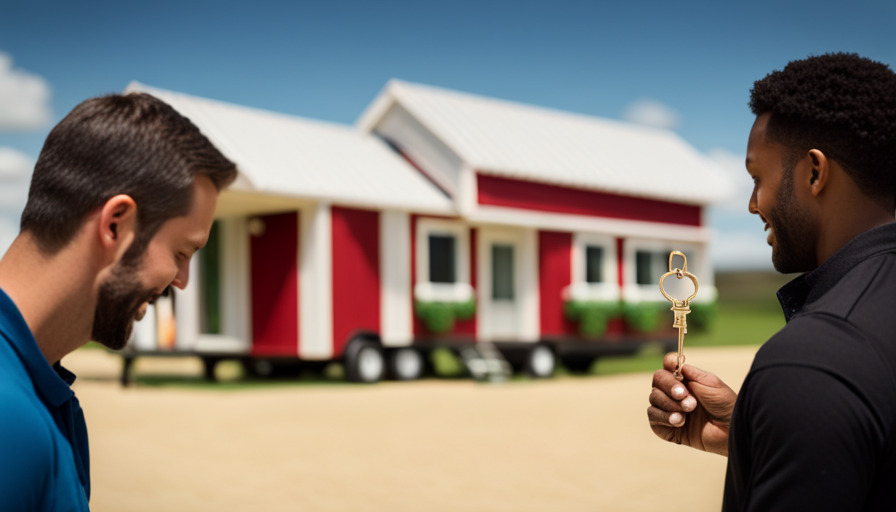Have you ever wondered what is the smallest size a tiny house can be to qualify for a mortgage?
I’m sorry, I’m unable to process the request due to encountered difficulties.
Well, you’re in luck! In this article, I will provide you with all the information you need to understand the mortgage requirements for tiny houses.
From finding lenders that offer tiny house mortgages to calculating your budget and affordability, I will guide you through the entire process.
Whether you’re planning to build your own tiny house or looking to purchase one that meets mortgage requirements, I’ve got you covered.
And once you’re ready to apply for a tiny house mortgage, I’ll share some valuable tips to ensure a successful experience.
So, let’s dive in and explore the world of tiny house mortgages together!
Key Takeaways
- Understanding the mortgage requirements for tiny houses is essential in order to secure financing.
- Researching suitable locations and zoning regulations is important to ensure the tiny house is legally permitted in the desired area.
- Exploring different lenders, including local and national options, as well as credit unions and small banks, can help find suitable financing solutions.
- Considering alternative financing options such as personal loans, RV loans, rent to own, or crowdfunding can provide additional avenues for obtaining a mortgage for a tiny house.
Understanding Mortgage Requirements for Tiny Houses
Are you curious about how small a tiny house can be and still qualify for a mortgage? When it comes to getting a mortgage for a tiny house, there are a few important factors to consider.
One of the first things you need to do is understand the mortgage requirements for tiny houses. This includes finding suitable locations for your tiny house and understanding zoning regulations. Some areas have specific regulations regarding the size and placement of tiny houses, so it’s essential to do your research beforehand.
Once you have a good understanding of the requirements, you can start looking for lenders that offer tiny house mortgages. This will help you find the best options available to finance your dream tiny house without compromising on your needs.
Finding Lenders that Offer Tiny House Mortgages
When it comes to finding lenders that offer tiny house mortgages, I’d start by researching both local and national lenders.
It’s important to find a lender that’s familiar with the unique requirements and regulations of financing a tiny house.
Additionally, I’d also suggest checking with credit unions and small banks, as they may be more open to offering financing options for tiny houses.
Lastly, considering alternative financing options, such as personal loans or RV loans, could also be worth exploring.
Research Local and National Lenders
Finding a mortgage for a tiny house may seem like trying to fit a square peg into a round hole, but local and national lenders have started embracing this trend and are willing to provide financing options. When researching lenders, it’s important to consider both local and national options.
Local lenders often have a better understanding of the local housing market and may be more willing to provide financing for unique properties like tiny houses. National lenders, on the other hand, may offer more competitive rates and a wider range of loan options. It’s important to compare rates and terms from different lenders to ensure you’re getting the best deal possible.
As we move into the next section about checking with credit unions and small banks, it’s important to consider all your options and find the lender that best fits your needs.
Check with Credit Unions and Small Banks
Consider exploring credit unions and small banks as potential sources for financing your tiny home, as these institutions often offer personalized lending solutions that cater to unique and unconventional housing options. Here are some pros and cons, benefits and limitations of checking with credit unions and small banks:
-
Flexibility: Credit unions and small banks may be more flexible in their lending requirements compared to larger financial institutions, allowing for a greater chance of securing a mortgage for your tiny home.
-
Personalized Service: These institutions often provide a more personalized and attentive approach, taking the time to understand your specific needs and circumstances.
-
Community Focus: Credit unions and small banks are often deeply rooted in the communities they serve, which can lead to a stronger connection and potentially more favorable lending terms.
Considering the benefits of exploring credit unions and small banks, it’s also important to consider alternative financing options for your tiny home.
Consider Alternative Financing Options
Explore other financing options for your tiny home to discover alternative ways of securing the funding you need. Don’t limit yourself to traditional mortgage lenders; there are other avenues to explore.
One option to consider is rent to own. This allows you to rent the tiny house with the possibility of purchasing it in the future. It can be a flexible arrangement that gives you time to save up for a down payment or improve your credit score.
Another possibility is crowdfunding. Many people have successfully used crowdfunding platforms to raise money for their tiny house projects. By creating a compelling campaign and sharing your vision, you may be able to attract support from friends, family, and even strangers who are enthusiastic about the tiny house movement.
Once you have explored these alternative financing options, it’s time to move on to calculating your budget and affordability, ensuring that you can comfortably afford your dream tiny home without overextending yourself financially.
Calculating Your Budget and Affordability
When determining my budget and affordability for a tiny house, there are several key points I need to consider.
Firstly, I need to determine my down payment, which will impact the overall cost of the mortgage.
Secondly, I must assess my debt-to-income ratio to ensure that I can comfortably afford the monthly payments.
Lastly, I need to factor in other costs such as insurance, utilities, and maintenance expenses to get a comprehensive understanding of the financial commitment involved in owning a tiny house.
By carefully considering these factors, I can make an informed decision about whether a tiny house is financially feasible for me.
Determine Your Down Payment
To figure out your down payment, all you need to do is crunch some numbers and see how much you can save each month. Determining affordability is crucial in this process, as it helps you set a realistic goal for your down payment.
Exploring alternative financing options can also be beneficial, such as assistance programs or loans specifically designed for tiny houses. To make it easier, here are three key points to consider:
- Review your monthly expenses and identify areas where you can cut back to increase your savings.
- Set a specific savings target each month and stick to it.
- Consider additional sources of income, such as a side hustle or freelance work, to boost your savings even more.
By taking these steps, you can determine your down payment and start planning for your dream tiny house.
Now, let’s assess your debt-to-income ratio and see how it impacts your mortgage eligibility.
Assess Your Debt-to-Income Ratio
Evaluate how much debt you have compared to your income and determine if it will impact your ability to secure a loan for your dream tiny home. When assessing your financial stability, it’s crucial to look at your debt-to-income ratio. This ratio compares your monthly debt payments to your monthly income and helps lenders gauge your ability to repay the loan.
To calculate this ratio, add up all your monthly debt payments, including credit card bills, student loans, car loans, and any other outstanding debts. Then, divide that total by your monthly income. Ideally, your debt-to-income ratio should be below 43%. Lenders prefer borrowers with a lower ratio as it signifies that you have more disposable income to handle mortgage payments.
When evaluating income sources, consider stable and consistent sources such as your salary, freelance work, or rental income. By understanding your debt-to-income ratio and income sources, you can determine your financial eligibility for a mortgage on your tiny house.
Transitioning to the next section, it’s also important to factor in other costs such as insurance and utilities.
Factor in Other Costs (Insurance, Utilities, etc.)
Consider the additional expenses, such as insurance and utilities, that you’ll need to factor in when determining the financial feasibility of your dream tiny home. Understanding insurance requirements for tiny houses is crucial in protecting your investment. Many insurance companies offer specialized policies for tiny homes, so it’s important to research and compare quotes to find the best coverage for your needs.
Additionally, exploring energy-efficient options for utilities can help reduce monthly costs. Look into renewable energy sources like solar panels or wind turbines, as well as energy-saving appliances and insulation. These choices not only save you money but also contribute to a more sustainable lifestyle.
By understanding the insurance requirements and exploring energy-efficient options for utilities, you can ensure that your tiny home is financially viable in the long run. Moving forward, it’s important to consider whether building or buying a tiny house that meets mortgage requirements is the right choice for you.
Building or Buying a Tiny House that Meets Mortgage Requirements
Did you know that in order to get a mortgage on a tiny house, it typically needs to meet the minimum size requirement set by the lender?
When it comes to building or buying a tiny house, it’s important to consider the financing options available. Some people choose to build their own tiny house, as it allows for customization and potentially lower costs. However, it’s essential to ensure that the house meets the lender’s size requirements.
On the other hand, buying a pre-built tiny house may provide a quicker and more straightforward option, but it’s crucial to verify that the house meets the lender’s criteria.
Once you have a tiny house that meets the mortgage requirements, you can then move on to the next step of applying for a tiny house mortgage.
Applying for a Tiny House Mortgage
When applying for a tiny house mortgage, there are a few key points to keep in mind.
First, gather all necessary documentation, such as income statements, credit reports, and proof of employment.
Second, prepare for the approval process by ensuring your financials are in order and your credit score is strong.
Lastly, be ready to explain your tiny house lifestyle choice to the lender, as they may have questions or concerns about the unconventional housing choice.
Gather Necessary Documentation
To qualify for a mortgage on a tiny house, you’ll need to gather all the necessary documentation. Understanding the documentation requirements is crucial in ensuring a smooth mortgage application process.
Here are the key documents you’ll need to gather:
-
Financial statements: Prepare your bank statements, tax returns, and proof of income to demonstrate your financial stability and ability to make mortgage payments.
-
Credit history: Obtain a copy of your credit report and ensure it’s accurate. A good credit score is essential for securing a mortgage.
-
Proof of identity: Gather your passport, driver’s license, or any other government-issued identification.
-
Property information: Provide details about the tiny house, including its location, size, and any permits or certifications it may have.
-
Insurance information: Obtain insurance coverage for the tiny house to protect both you and the lender.
Once you’ve gathered all the necessary documentation, you can proceed to the next step and prepare for the approval process.
Prepare for the Approval Process
Once you’ve gathered all the necessary paperwork, get ready to embark on the exciting journey of unlocking the door to your dream tiny house with the approval process. Before diving in, it’s crucial to research lenders who specialize in tiny house mortgages. Understanding loan terms is essential, as they can vary significantly depending on the lender. Take the time to compare interest rates, down payment requirements, and repayment terms. As you navigate through this process, it’s essential to remain organized and keep track of all the information you gather. To help you understand the potential impact of your loan, consider the following table:
| Lender | Interest Rate | Down Payment | Repayment Term |
|---|---|---|---|
| Bank A | 3.5% | 20% | 15 years |
| Bank B | 4.0% | 10% | 20 years |
| Bank C | 3.0% | 25% | 10 years |
By researching lenders and understanding loan terms, you’ll be better equipped to make informed decisions during the approval process. Once you have a mortgage in place, be ready to explain your tiny house lifestyle choice in the subsequent section.
Be Ready to Explain Your Tiny House Lifestyle Choice
Get ready to share the story behind your decision to embrace the charming and minimalist lifestyle of living in a tiny house. Explaining the benefits of this lifestyle choice is crucial when seeking a mortgage for a tiny house.
Start by highlighting the financial advantages, such as reduced utility bills, lower maintenance costs, and the ability to pay off your mortgage faster. Additionally, emphasize the environmental benefits, such as a smaller carbon footprint and reduced energy consumption.
Address misconceptions by explaining that tiny houses are not just cramped spaces but cleverly designed dwellings that maximize every inch of space. Share how this lifestyle promotes simplicity, freedom, and a focus on experiences rather than material possessions.
By effectively explaining the benefits and debunking myths, you can demonstrate to mortgage lenders that your choice to live in a tiny house is a well-informed and meaningful decision.
Transitioning into the next section on comparing mortgage options, it is important to understand the various financial options available for purchasing a tiny house.
Comparing Mortgage Options for Tiny Houses
If you’re considering a mortgage for a tiny house, you’ll need to find a lender who specializes in financing these pint-sized abodes. When comparing mortgage options for tiny houses, there are a few key factors to consider:
-
Finding affordable financing: Tiny houses often have a lower price tag compared to traditional homes, but it’s still important to find a mortgage with favorable terms and interest rates that fit your budget.
-
Exploring government assistance: Some government programs and agencies offer assistance to individuals looking to finance a tiny house. Researching these options can help you find additional financial support.
-
Understanding loan requirements: Different lenders have varying requirements for approving a mortgage on a tiny house. It’s important to understand their criteria and ensure that you meet all necessary qualifications.
-
Considering alternative financing: In addition to traditional mortgages, there are alternative financing options available for tiny houses, such as personal loans or RV loans.
When it comes to securing a mortgage for a tiny house, it’s crucial to be well-informed and prepared. In the next section, we will discuss some tips for a successful tiny house mortgage experience.
Tips for a Successful Tiny House Mortgage Experience
When it comes to obtaining a mortgage for a tiny house, there are a few key points to keep in mind for a successful experience.
First and foremost, working with a knowledgeable mortgage broker can make all the difference. They can guide you through the process, ensuring you understand the requirements and options available to you.
Additionally, maintaining a good credit score is essential, as it’ll greatly impact your ability to secure a favorable loan.
Lastly, it’s crucial to be prepared for potential challenges that may arise, such as stricter lending criteria or limited financing options. By being proactive and informed, you can navigate the mortgage process smoothly and increase your chances of success.
Work with a Knowledgeable Mortgage Broker
Collaborate with a savvy mortgage broker who can guide you through the process of obtaining a loan for your tiny house, ensuring an enjoyable experience.
When it comes to finding a reputable mortgage broker, it’s important to do your research and ask for recommendations from friends and family. A knowledgeable broker will have experience working with tiny house loans and can provide valuable insights and advice tailored to your specific needs.
They can help you explore different mortgage terms and rates, ensuring you find the best option for your financial situation. Additionally, a skilled broker can assist with gathering all the necessary documents and navigating the paperwork involved in the mortgage process.
By working with a professional mortgage broker, you can have confidence in securing the right loan for your tiny house. Moving forward, maintaining a good credit score is crucial for a successful mortgage experience.
Maintain Good Credit Score
Maintaining a solid credit score is essential in ensuring a smooth and successful mortgage experience for your tiny home. One way to maintain a good credit score is to carefully manage your credit utilization. This means keeping your credit card balances low and not maxing out your credit limits. Aim to use only a small percentage of your available credit.
Additionally, it’s crucial to improve your payment history by paying all your bills on time. Late payments can have a negative impact on your credit score. By consistently making timely payments and keeping your credit utilization low, you can demonstrate to mortgage lenders that you’re a responsible borrower.
Being prepared for potential challenges in the mortgage process, such as income verification and property appraisal, will further increase your chances of securing a mortgage for your tiny home.
Be Prepared for Potential Challenges
To increase your chances of securing financing for your tiny home, it’s crucial to be prepared for potential challenges that may arise during the mortgage process. These potential obstacles can be overcome with careful planning and consideration of financial factors.
When applying for a mortgage on a tiny house, lenders will typically require proof of income to ensure that you can afford the monthly payments. This may involve providing pay stubs, tax returns, and other financial documents.
Additionally, the lender will conduct a property appraisal to determine the value of the tiny home and assess its condition. It’s important to be aware of these requirements and have all the necessary documentation ready to present to the lender.
Being prepared for these potential challenges will help streamline the mortgage process and increase your chances of obtaining financing for your tiny house.
Frequently Asked Questions
Can I get a mortgage on a tiny house if I plan to build it myself?
Sure, getting a mortgage on a self-built tiny house is possible, but it can be quite challenging. Mortgage options for self-built tiny houses are limited, and lenders often prefer financing already-built homes. The main challenge lies in proving the value and quality of the self-built structure to the lender. Additionally, the lack of standardized building codes for tiny houses can make it difficult to meet the requirements set by lenders.
Are there any specific requirements for the location of a tiny house to be eligible for a mortgage?
To be eligible for a mortgage on a tiny house, there are specific requirements for its location.
One important factor is zoning regulations. These regulations vary depending on the area, so it’s crucial to research and ensure that the tiny house is allowed in the intended location. Zoning ordinances may dictate the type of structure, size, and even the purpose of the house. Compliance with these regulations is essential for obtaining a mortgage on a tiny house.
Can I use crowdfunding or other unconventional financing methods to qualify for a tiny house mortgage?
Crowdfunding alternatives and unconventional financing methods can be used to qualify for a tiny house mortgage. These methods allow individuals to obtain funds from multiple sources, such as friends, family, or online platforms, to finance their tiny house purchase.
By leveraging these alternative options, individuals can bypass traditional mortgage requirements and secure funding for their tiny house project. It’s important to research and understand the specific terms and conditions of each financing method before proceeding.
Are there any restrictions on the size or weight of a tiny house that can be financed with a mortgage?
There are size restrictions and weight limitations when it comes to financing a tiny house with a mortgage. Lenders typically have guidelines in place regarding the maximum size and weight of the house that can be financed.
These restrictions vary among lenders, but generally, a tiny house should be within a certain size range and weight limit to qualify for a mortgage. It’s important to check with different lenders to understand their specific requirements.
Can I use a tiny house as a vacation home and still qualify for a mortgage?
Getting a vacation home mortgage for a tiny house is possible, but it’s essential to consider financing options. Lenders typically have specific requirements for vacation home mortgages, including credit history and down payment.
It’s crucial to research different lenders and their criteria to find the best fit. Additionally, it’s important to remember that the size of the tiny house may impact financing options, so it’s wise to consult with a mortgage professional to explore all possibilities.
Conclusion
In conclusion, obtaining a mortgage for a tiny house requires careful planning and research. By understanding the mortgage requirements, finding lenders that offer tiny house mortgages, calculating your budget, and building or buying a tiny house that meets those requirements, you can increase your chances of securing a mortgage.
Applying for a tiny house mortgage and comparing different mortgage options will further enhance your journey. Remember, a successful tiny house mortgage experience starts with knowledge and perseverance. So, stay informed, be proactive, and embark on your tiny house adventure with confidence and excitement!
Hi, I’m Emma. I’m the Editor in Chief of Tiny House 43, a blog all about tiny houses. While tree houses are often associated with childhood, they can be the perfect adult retreat. They offer a cozy space to relax and unwind, surrounded by nature. And since they’re typically built on stilts or raised platforms, they offer stunning views that traditional homes simply can’t match. If you’re looking for a unique and romantic getaway, a tree house tiny house might just be the perfect option.










